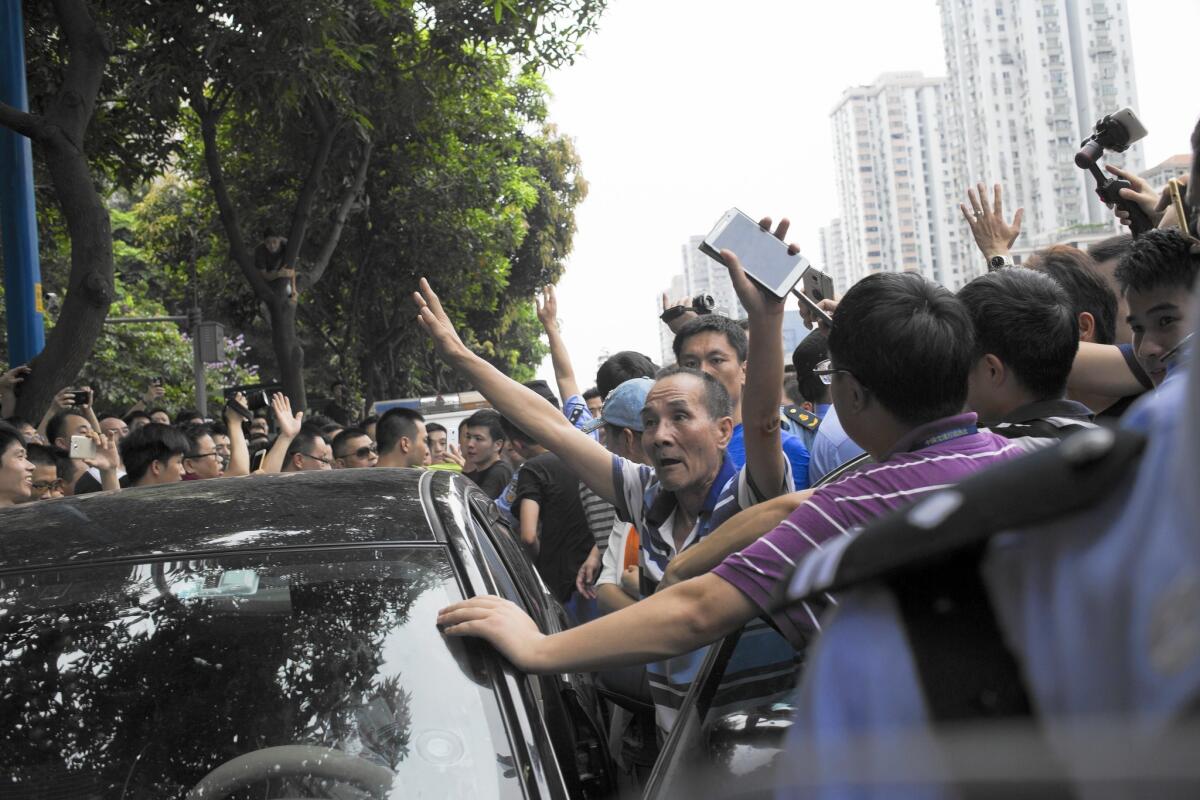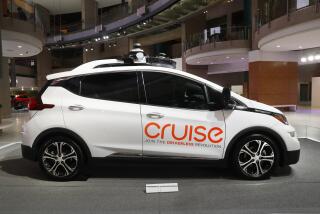Ride-hailing firm Uber faces big challenges in China

Drivers of Didi Kuaidi, Uber’s biggest rival in China, protest an attempt to arrest a fellow driver in Guangzhou on June 10. Uber has faced government raids, police crackdowns and cab driver protests.
- Share via
Reporting from beijing — From 7 p.m. until dawn, Zhou Xiuquan plies the streets of Beijing, picking up fares in his yellow-and-blue Hyundai taxi, shuttling people home from work, out to bars and to the airport for early-morning flights. But at 7 a.m., he parks his cab, hops into his personal Kia, fires up his Uber app and starts driving for what he calls “real money.”
“Every week, I’m making 5,000 kuai [$800] with Uber — that’s as much as I make all month in my cab,” Zhou says. “They’re offering a lot of bonuses and subsidies, trying to build customers and enter the Chinese market. A rider might pay 20 kuai, even less than they’d pay in a cab, but I get 60.”
Still, Zhou, who’s been a cabbie for 20 years, isn’t giving up on his taxi yet. “I’m keeping the taxi, because I’m worried the government might shut down Uber. If that happens, I want to have the taxi to fall back on.”
Since first dipping its toe in the China market in 2013, Uber’s peer-to-peer ride business has faced government raids, police crackdowns, protests from irritated cabbies and intense competition from Chinese taxi-hailing and ride-sharing apps backed by some of China’s largest Internet companies, including Alibaba and Tencent.
Still, the San Francisco company has fought its way into nine Chinese cities — with four more in the process of launching — and Uber spokeswoman Xue Huang says the company is providing close to 1 million rides a day in China. Now, Uber appears poised to mount a business battle royale in the world’s most populous country.
“Competition in China is strong,” said Minyuan Zhao, associate professor of management at the Wharton School of the University of Pennsylvania. “Throwing current incumbents off the throne will be a big challenge.”
For Uber, success in China is crucial. Investments in the start-up imply a market valuation that tops $40 billion. “China is critical to their current valuation,” Zhao said. A stumble there would take “a big chunk from their current $40-billion valuation.”
In a recent email to investors, first disclosed in the Financial Times, Uber Chief Executive Travis Kalanick said the company planned to “double down” on China and expand into 50 cities within the next year and invest $1 billion in the market in 2015 alone. “China is the #1 priority for Uber’s global team,” he wrote.
It’s a daring move in a market known for its cutthroat competition and murky regulatory landscape, not to mention aversion to some foreign tech and e-commerce companies. Uber has a formidable rival in the form of Didi Kuaidi, which started out in the taxi-hailing app business and is moving into the private-ride market — and could easily draw on its massive database of millions of cab riders in hundreds of cities.
Growing demand for transportation is intrinsic to economic expansion, and China’s congested and pollution-choked cities are desperate for solutions. “The demand for a ride is far outstripping people’s abilities to buy cars and it’s outstripping other transportation infrastructure,” said Julie Ask, principal analyst at Forrester Research. Cabs are often in short supply, and even if you want to buy your own car or motorcycle, metropolises like Beijing issue only a certain number of license plates per year, rationing them through a lottery system.
To cut traffic and smog, Beijing also has a rotating schedule of “no drive” days based on your license plate number; drivers are fined if they’re caught on the road on their blackout day.
That may spell opportunity for Uber.
“Round One was taxi-hailing, and Uber got knocked down, but not out,” said Jeffrey Towson, a professor of investment at Peking University and author of “The 1 Hour China Consumer Book.” “Round Two will be p-2-p ride sharing. That fight will be mostly about using capital to buy customers. Uber’s $1 billion for China looks formidable.”
Still, he said, “this depends on government approval of p-2-p ride sharing, which is still mostly illegal in China.”
Just as Uber has encountered differences in regulations state by state in the U.S., so it has in China. In January, Beijing’s Transportation Commission declared “special services” of Uber and similar providers illegal. In April, Guangzhou’s police and Transportation Commission cracked down on Uber, confiscating 1,000 iPhones, according to reports in state-run media.
Uber did not respond to a request for comment on the legality of its services in China.
Some localities have couched their concerns as a safety issue, but in other cases the investigations look to be more financially motivated, as local interest groups, including state-run taxi companies, are upset that services such as Uber are encroaching on their turf and profits. Guangzhou’s Transportation Committee even unveiled a service that directly competes with Uber a week after its raid on Uber’s office.
But a change in tone lately from authorities may signal a shift. Dai Dongchang, acting vice minister of Transport, said this month that regulators are studying car-on-demand apps and preparing to draft regulations.
“The new trends are the results of openness and innovation,” he told state-run China Daily. “For regulators, the ultimate goal is to promote better development within the industry.”
Uber began trial operations in the expatriate-heavy metropolis of Shanghai in 2013. Despite initially offering only an English-language app and relying on Google Maps, which are less accurate in China than they are stateside, it found a base of clients. Uber improved its service by switching map providers and introducing a Chinese-language app (the service is called You-bu, or “excellent step” in Mandarin). Uber also signed a partnership with Chinese search engine giant Baidu, giving Uber access to Baidu’s mapping and search services.
As it has sought to crack the market, Uber has been trying to set itself apart with high-quality cars, a streamlined interface, and headline-grabbing special events much like the ones the company is known for in the United States. During Chinese New Year 2014, for instance, Uber customers could order a lion dance team to perform at their home or office; the day the iPhone 6 went on sale, users could have Uber buy and deliver one of the much-coveted devices for them.
Uber even tried out a puppy-delivery day, bringing cute dogs to customers’ offices for 15 minutes of playtime. This month, it delivered lunches.
But now, Uber seems to be spending like there’s no tomorrow to attract customers and drivers. In Shanghai, for instance, Uber drivers interviewed last week said they are being paid two to three times the fare the customer pays during rush hour and are receiving additional bonuses for working a certain number of hours.
And fares in Shanghai of late have been even cheaper than cabs — a 2.9-mile ride last week taken via “People’s Uber,” the lowest level of service, cost just $2.12. People’s Uber is operated on a not-for-profit basis, meaning Uber gets no cut of those fares.
Besides the low fares, Uber users say they appreciate the fact that Uber drivers do not refuse rides based on a rider’s destination (a common practice among Chinese taxi drivers) and are, in the words of one customer, “more educated and reasonable” than cabbies.
“My experience with Uber has been good — the drivers haven’t rejected me and never will,” said Lin Yang, a 39-year-old sales representative in Shanghai. “Yesterday, my daughter was sick and it was pouring rain. I knew it would take forever to get a taxi, and we would probably be wet by the time we got one. So we got an Uber. We paid extra fees, but it was worth it. My daughter got treated in time and we avoided lots of stress.”
Assuming the government starts to relax its restrictions on ride-hailing apps, Towson said, in the near-term, Chinese consumers are in for a bonanza as Uber and Didi Kuaidi look to be gearing up for a subsidy war. “It’s going to be great for us; we are going to get lots of free rides.”
But if Didi Kuaidi can quickly leverage its taxi customers into private-ride users, the war might not last long. “That, plus their big funding, could be devastating for Uber,” he said.
Further out, other big questions remain, including defining the monetization strategy and determining the ultimate price point. Chinese consumers have a well-documented history of taking advantage of promotions and freebies, then abandoning a brand when the discounts dry up.
A part-time Uber driver in Shanghai, who asked to be identified only by his surname, Wang, because he feared souring his relationship with the company, said that if Uber cuts its extra payments, it will have to raise fares or figure out some other way to keep his income up. “Otherwise, why would I continue driving?”
Huang said Uber’s incentives per trip are lower in China than in other global markets, and that the business “continues to grow at a very healthy rate even as we have been reducing incentives.”
But Towson said more time is needed before Uber can declare it’s on solid ground in China. Besides clarifying the legal status of Uber, “the question is, what happens when the subsidies are over?” he asked. “Will users and drivers just stop?”
Nicole Liu in The Times’ Beijing bureau and Tracey Lien in San Francisco contributed to this report.
More to Read
Inside the business of entertainment
The Wide Shot brings you news, analysis and insights on everything from streaming wars to production — and what it all means for the future.
You may occasionally receive promotional content from the Los Angeles Times.











